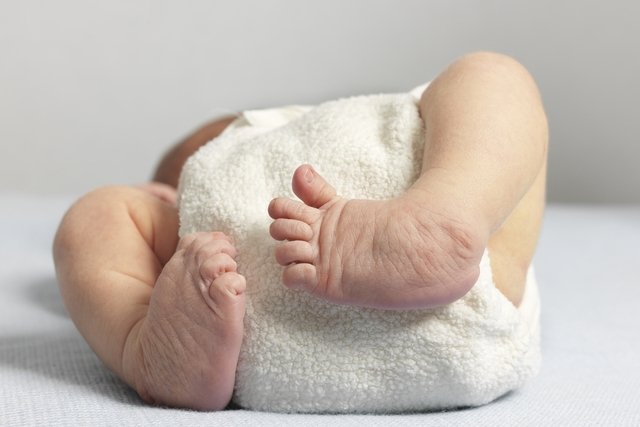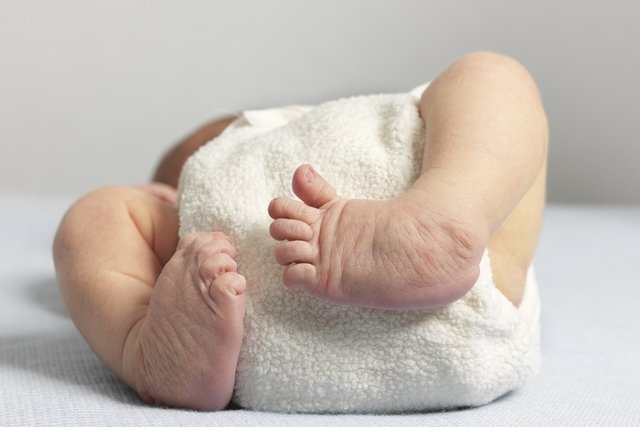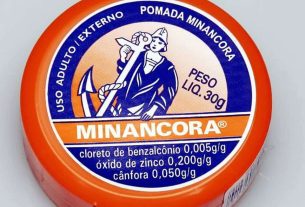Congenital clubfoot, also known as equinovarus congenital clubfoot or, popularly, as “inward clubfoot”, is a congenital malformation in which the baby is born with one foot or both feet turned inwards.
This change can be identified during pregnancy, through ultrasound examination, but is only confirmed after birth by observing the position of the feet, without the need to carry out any other examination to confirm the diagnosis.
Congenital clubfoot can be cured as long as the treatment is carried out in accordance with the guidance of the pediatrician and orthopedist, and the Ponseti method, which consists of using a plaster cast and orthopedic boots, or surgery to correct the position may be recommended. of the feet, however surgery is only indicated when other treatment methods have no effect.

How to identify
The identification of congenital clubfoot can be done during pregnancy by performing an ultrasound, and the change in the position of the feet can be visualized through this exam. However, confirmation of congenital clubfoot is only possible after birth through a physical examination, and it is not necessary to perform any other imaging examination, in which the following can be observed:
- Feet facing downwards;
- Front part of the feet facing inwards, towards the opposite leg;
- Thinner calf;
- Feet smaller than normal for age.
After confirming congenital clubfoot, the doctor may recommend carrying out other tests with the aim of identifying the possible cause, as it may be associated with genetic or neuromuscular changes, or just a postural change, improving over time. . This way, it is possible to start the most appropriate treatment.
Possible causes
The causes of clubfoot are still unknown and widely discussed, however some researchers believe that this condition is essentially genetic and that throughout the baby’s development, genes responsible for this deformity have been activated.
Another theory also accepted and discussed is that cells with the ability to contract and stimulate growth may be present in the inner part of the leg and foot and that, when contracting, direct the growth and development of the feet inward.
Although there are several theories regarding the occurrence of clubfoot, it is important that treatment is started early to guarantee the child’s quality of life.
Treatment for congenital clubfoot
It is possible to correct clubfeet as long as treatment is started quickly. The ideal age to start treatment is controversial, with some orthopedists recommending that treatment be started soon after birth, and by others that it only be started when the baby turns 9 months old or when it is around 80 cm tall.
Treatment can be carried out through manipulations, which corresponds to conservative treatment, or surgery, which is only indicated when the first method is not effective.
Conservative treatment
The main method of manipulation for treating clubfoot is known as the Ponseti method, which involves the orthopedic doctor manipulating the child’s legs and placing a plaster cast every week for about 5 months to ensure correct alignment of the foot bones and tendons. .
After this period, the child must wear orthopedic boots 23 hours a day, for 3 months, and at night until they are 3 or 4 years old, to prevent the foot from bending again. When the Ponseti method is performed correctly, the child can walk and develop normally.
However, in cases where the Ponseti method is not effective, surgery may be indicated, which must be carried out before the child turns 1 year old. In this surgery, the feet are placed in the correct position and the Achilles tendon is lengthened, called tenotomy. Although it is also effective and improves the appearance of the child’s foot, it is possible that over time the child will lose strength in the muscles of the legs and feet, which over time can cause pain and become stiff.
Additionally, physical therapy for congenital clubfoot can help by improving correct foot position and strengthening the muscles in the child’s legs and feet.
Surgery for congenital clubfoot
In cases where the Ponseti method is not effective, surgery may be indicated, which must be carried out before the child turns 1 year old. In this surgery, the feet are placed in the correct position and the Achilles tendon is lengthened, called tenotomy.
Although it is also effective and improves the appearance of the child’s foot, it is possible that over time the child will lose strength in the muscles of the legs and feet, which over time can cause pain and become stiff.
Therefore, physical therapy for congenital clubfoot can help strengthen the leg muscles and help the child to support their feet correctly. Physiotherapy treatment for congenital clubfoot includes manipulations, stretching and taping to help position the feet.

Sign up for our newsletter and stay up to date with exclusive news
that can transform your routine!
Warning: Undefined array key "title" in /home/storelat/public_html/wp-content/plugins/link-whisper-premium/templates/frontend/related-posts.php on line 12
Warning: Undefined array key "title_tag" in /home/storelat/public_html/wp-content/plugins/link-whisper-premium/templates/frontend/related-posts.php on line 13




